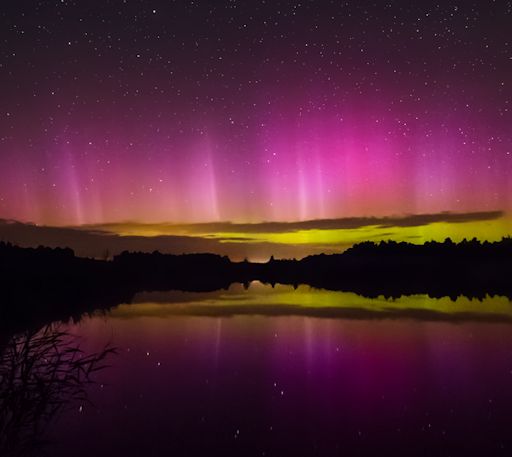When is the best time to see auroras? Where is the best place to go? And how do you photograph them? These questions and more are answered in a new book, Northern Lights - a Guide, by Pal Brekke & Fredrik Broms. | | | MYSTERY IN THE OZONE LAYER: More than 27 years after the Montreal Protocol regulated chemicals that destroy ozone, a damaging compound named carbon tetrachloride (CCl4) is still surprisingly abundant in the ozone layer. "We are not supposed to be seeing this at all," says NASA atmospheric scientist Qing Liang. Countries around the world report zero emissions of CCl4, yet the amount actually in the ozone layer corresponds to 39 kilotons per year. Where is the compound coming from? Some of the possibilities are discussed in a NASA press release. WEAK IMPACT? MAGNIFICENT AURORAS: Visually, the CME that struck Earth's magnetic field on August 19th was dim and unimpressive. The auroras it produced were magnificent. "For the first time in my life, I saw the Northern Lights," says Tadas Janušonis who sends this photo from Vabalninkas, Lithuania: 
"It is a very rare phenomenon here in Lithuania," he says, "but the August 19th impact was strong enough to [produce] them." Actually, the impact was weak. A CME like this one hits with a mechanical pressure of no more than 1 or 2 nanoPascals. That's 1 or 2 billionths of a Pascal - softer than a baby's breath. The reason it was so effective had more to do with its inner magnetic structure. This CME contained a region of south-pointing magnetism that partially canceled Earth's north-pointing magnetic field, opening a crack in the magnetosphere. Solar wind poured and fueled the display. The most famous photo of the storm, so far, was taken by astronaut Reid Wiseman onboard the International Space Station. "Never in my wildest dreams did I imagine this, " he tweeted. "Unbelievable." Yet many more photos prove that it really did happen! Aurora alerts: text, voice Realtime Aurora Photo Gallery MORNING SHOW CONTINUES: Light pollution? No problem. The morning conjunction of Venus and Jupiter is bright enough to see through the worst urban glare. Jeff Dai sends this picture from metropolitan Chongqing, China: 
"I woke up at 5 AM to enjoy this celestial dawn above the cityscape," says Dai. "It was gorgeous." Dai took the picture on August 20th, two days after Venus and Jupiter were barely 0.2o apart. Many observers have stopped looking now that the planets are separating, but as Dai's photo shows, they are still a beautiful pair. So set your alarm for dawn: the morning show continues. A date of special interest is August 23rd when the crescent Moon joins the planets to form a must-see celestial triangle. A video from NASA previews the meeting. Realtime Conjunction Photo Gallery
Realtime Comet Photo Gallery
Realtime Meteor Photo Gallery
Realtime NLC Photo Gallery
Every night, a network of NASA all-sky cameras scans the skies above the United States for meteoritic fireballs. Automated software maintained by NASA's Meteoroid Environment Office calculates their orbits, velocity, penetration depth in Earth's atmosphere and many other characteristics. Daily results are presented here on Spaceweather.com. On Aug. 21, 2014, the network reported 32 fireballs.
(30 sporadics, 2 kappa Cygnids)  In this diagram of the inner solar system, all of the fireball orbits intersect at a single point--Earth. The orbits are color-coded by velocity, from slow (red) to fast (blue). [Larger image] [movies] Potentially Hazardous Asteroids ( PHAs) are space rocks larger than approximately 100m that can come closer to Earth than 0.05 AU. None of the known PHAs is on a collision course with our planet, although astronomers are finding new ones all the time. On August 21, 2014 there were 1495 potentially hazardous asteroids. Notes: LD means "Lunar Distance." 1 LD = 384,401 km, the distance between Earth and the Moon. 1 LD also equals 0.00256 AU. MAG is the visual magnitude of the asteroid on the date of closest approach. | | The official U.S. government space weather bureau | | | The first place to look for information about sundogs, pillars, rainbows and related phenomena. | | | Researchers call it a "Hubble for the sun." SDO is the most advanced solar observatory ever. | | | 3D views of the sun from NASA's Solar and Terrestrial Relations Observatory | | | Realtime and archival images of the Sun from SOHO. | | | from the NOAA Space Environment Center | | | the underlying science of space weather | | 
